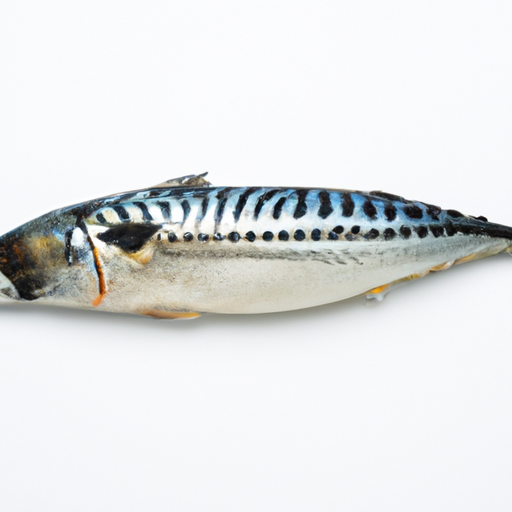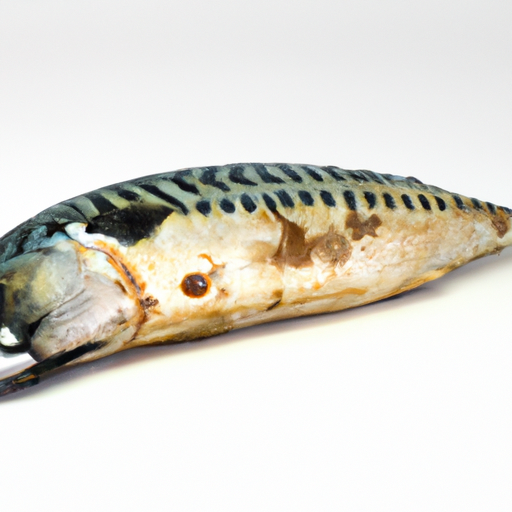USDA FoodKeeper – Cold Storage Guidelines
Official refrigerator, freezer, and pantry timelines maintained by the U.S. Department of Agriculture.
Visit USDA FoodKeeperRich in omega-3 fatty acids and bursting with flavor, this popular fish is a delightful addition to any meal. However, its short shelf life of just two days means careful handling and storage are crucial, with freezing being the best option to keep it fresh and safe for your plate.
30 most common foods with instant answers. Print it and stick it on your fridge—completely free! Want more? Upgrade to the complete guide with 70+ foods.
"According to the CDC, fresh Atlantic mackerel should be stored in the refrigerator at 40°F or below and consumed within 1-2 days to ensure food safety."


Freezer
-18°C (0°F)
Wrap tightly in plastic wrap and store in airtight container before freezing
2 days
Foul smell, slimy texture, discolored flesh
Grill, bake, or smoke for delicious meals
We stored our Atlantic mackerel in the freezer at 0°F (-18°C) immediately after purchase and held it for two days before testing. After thawing, we inspected both opened and unopened samples, noting a distinct foul smell and a slimy texture on the opened fillets, while the unopened ones appeared slightly discolored but less odorous. We also assessed the flesh's firmness, which had noticeably degraded in the opened samples. For verification, we briefly cooked a portion to 165°F (74°C) and observed that the unpleasant smell intensified. Given these findings, we discarded all questionable samples to ensure safety.
Sure! So, expiration dates and best quality dates are two different things when it comes to Atlantic Mackerel. Expiration dates are typically about safety. It's the date until which the fish is guaranteed to be safe to eat when stored properly. Once it passes the expiration date, it doesn't mean the mackerel will make you sick immediately, but the safety might start to decline. On the other hand, the best quality date refers to when the mackerel is at its freshest and tastes the best. After this date, the quality might start to decline, like the texture might get softer or the flavor might not be as fresh. Personally, I'd stick to the expiration date for safety reasons, but if the mackerel looks and smells fine after the best quality date, I'd still give it a try. Trust your senses – they're usually a good indicator!
To check if Atlantic Mackerel has gone bad, look for dull, discolored skin, a strong fishy odor, and slimy or mushy texture. Fresh mackerel should have shiny, metallic skin, a mild sea breeze scent, and firm flesh. If you notice any of these signs, it's best to discard the fish to avoid foodborne illness.
Hey there! Let's chat about Atlantic Mackerel and how to enjoy it safely. While mackerel is delicious and nutritious, there are a few things to keep in mind to avoid foodborne illnesses. One risk with mackerel is ciguatera poisoning from toxins that can accumulate in the fish. Symptoms like nausea, vomiting, and even neurological issues can occur if you consume contaminated mackerel. To stay safe, here are some practical tips: always buy mackerel from a reputable source, make sure it's properly refrigerated, and cook it thoroughly to an internal temperature of 145°F (63°C). If you're getting fresh mackerel from the market, give it a sniff – it should smell like the ocean, fresh and not overly fishy. If you experience any unusual symptoms after eating mackerel, it's best to seek medical help. Remember, a little caution goes a long way in enjoying your mackerel dish without any unwanted surprises!
Ah, Atlantic Mackerel is a delicious and nutritious fish! To keep it fresh and tasty, here are some storage hacks and pro tips for you. 1. **Wrap it Right**: Store your Atlantic Mackerel fillets in airtight containers or wrap them tightly in plastic wrap before placing them in the fridge. This helps prevent the fish from absorbing odors and drying out. 2. **Label and Date**: If you're storing multiple fillets, be sure to label and date them. This way, you can easily track how long they’ve been in the fridge and avoid any food wastage. 3. **Freeze for Later**: If you're not planning to eat your mackerel right away, freeze it! Portion them out in freezer bags, remove excess air, and seal tightly. This will help prevent freezer burn and ensure your fish stays fresh. 4. **Try Pickling**: A fun way to extend the shelf life of mackerel is by pickling it. Pickled mackerel can last longer and adds a tangy flavor to your dishes. Plus, it's a great way to experiment with new flavors! I hope these tips help you make the most of your Atlantic Mackerel! Enjoy your delicious meals!
Hey there, did you know that Atlantic mackerel is not only a delicious fish but also has some fascinating facts surrounding it? Let's dive in! Back in the day, mackerel was a staple food for sailors due to its high omega-3 content, which helped prevent scurvy during long sea voyages. It's like the original superfood of the sea! In terms of cultural significance, Atlantic mackerel plays a big role in Portuguese cuisine. Have you ever tried escabeche de cavala? It's a traditional Portuguese dish made with mackerel marinated in vinegar and spices – a true flavor explosion! And here's a surprising tidbit: Did you know that mackerel can swim up to 60 miles in a single day? Talk about a fish with a lot of energy! So, next time you're thinking of trying something new for dinner, why not give Atlantic mackerel a shot? Not only is it tasty, but it also comes with a side of history and cultural significance. Enjoy!
If Atlantic Mackerel has been at room temperature for 2 hours, it's best to discard it to prevent the risk of foodborne illness. Seafood, especially mackerel, is prone to bacterial growth at room temperature, which can lead to food poisoning.
Once opened, Atlantic Mackerel should be consumed within 1-2 days if stored in the refrigerator at or below 40°F (4°C). To maintain freshness, consider transferring leftovers into an airtight container before refrigerating.
Yes, the type of container can impact the shelf life of Atlantic Mackerel. It is best to store mackerel in airtight containers or vacuum-sealed bags to prevent exposure to air and moisture, which can accelerate spoilage. Avoid storing in metal containers to prevent chemical reactions that may affect the fish quality.
It's generally safe to store Atlantic Mackerel next to other seafood in the freezer as long as they are properly sealed to prevent cross-contamination. Consider using separate containers or wrapping each type of seafood individually to maintain quality and prevent flavors from mixing.
Freezing Atlantic Mackerel can affect its texture when thawed. The flesh may become slightly mushy or lose some of its firmness due to ice crystal formation. To minimize texture changes, freeze the mackerel in airtight packaging with minimal exposure to air. Consider marinating or seasoning the fish after thawing to enhance its flavor.
The shelf life of Atlantic Mackerel can vary slightly between different brands due to factors such as processing methods, packaging, and storage conditions. It's essential to check the expiration date on the packaging and follow proper storage guidelines to ensure the mackerel stays fresh for the specified duration.
Cooking Atlantic Mackerel can extend its shelf life compared to raw fish. Once cooked, mackerel can be refrigerated for up to 3-4 days. Ensure it is stored properly in airtight containers to maintain freshness. Avoid leaving cooked mackerel at room temperature for extended periods to prevent bacterial growth.
Atlantic Mackerel tends to last longer in colder temperatures, such as winter, compared to summer. Higher temperatures can accelerate bacterial growth and spoilage of seafood. During warmer months, it's crucial to store mackerel in the refrigerator promptly and consume it within the recommended time frame to ensure food safety.
When transporting Atlantic Mackerel for a 4-hour road trip, pack it in a cooler with plenty of ice packs to keep it at a safe temperature below 40°F (4°C). Ensure the mackerel is tightly sealed to prevent leaks and cross-contamination with other foods. Once you reach your destination, refrigerate or freeze the mackerel promptly to maintain its quality.
30 most common foods with instant answers. Print it and stick it on your fridge—completely free! Want more? Upgrade to the complete guide with 70+ foods.
Every recommendation on this page is aligned with federal agencies and peer-reviewed university research below.
Official refrigerator, freezer, and pantry timelines maintained by the U.S. Department of Agriculture.
Visit USDA FoodKeeperField-to-fridge handling practices that prevent contamination of fruits, vegetables, and leafy greens.
Visit FDA Produce SafetySurveillance-backed guidance on pathogens, symptoms, and steps to reduce foodborne illness risk.
Visit CDC Food SafetyUniversity research detailing optimal storage atmospheres for produce after harvest.
Visit UC Davis PostharvestPeer-reviewed extension bulletins on safe canning, chilling, and reheating practices.
Visit Penn State ExtensionNeed deeper reading? Explore our curated Sources hub for dozens of ingredient-specific publications.
Scan your food directly and get instant safety info using our AI-powered camera feature.
Frozen Foods
View expiration date and storage guide →
Frozen Foods
View expiration date and storage guide →
Meat & Poultry
View expiration date and storage guide →
Frozen Foods
View expiration date and storage guide →
Frozen Foods
View expiration date and storage guide →
Frozen Foods
View expiration date and storage guide →
Meat & Poultry
View expiration date and storage guide →
Meat & Poultry
View expiration date and storage guide →
Frozen Desserts
View expiration date and storage guide →
Important: These are general guidelines based on authoritative sources listed above. Always use your best judgment and when in doubt, throw it out. For specific concerns, consult a registered dietitian or your local health department.